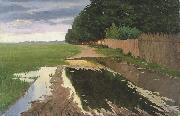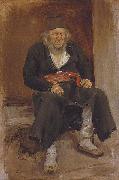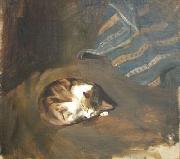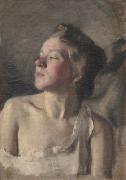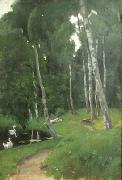Paul Raud El petróleo que Pinta la ReproducciónAll Paul Raud Oil Paintings(22 October 1865 in Kirikukela, Viru-Jaagupi Parish C 22 November 1930 in Tallinn) was an Estonian painter. The twin brother of painter Kristjan Raud, he studied in Desseldorf beginning in 1886, becoming influenced by the work of Eduard Gebhardt. After his return to Estonia, he painted mainly portrait commissions for some time, before traveling with his brother and Amandus Adamson to the islands of Muhu and Pakri in 1896. His works of this period are reminiscent of those of Max Liebermann. In 1899 he returned to work in Germany, taking on some of the stylistic trappings of Impressionism; this, coupled with time spent working with Ilya Repin, influenced his later style. Later in his career, most especially during and after World War I, he began to teach, from 1915 working as a drawing instructor at the Tallinn Institute of Commerce and from 1923 at the State School of Industrial Art in Tallinn. |
|||

|
|||
|
|
|||
|
||||||||
| Paul Raud (22 October 1865 in Kirikukela, Viru-Jaagupi Parish C 22 November 1930 in Tallinn) was an Estonian painter. The twin brother of painter Kristjan Raud, he studied in Desseldorf beginning in 1886, becoming influenced by the work of Eduard Gebhardt. After his return to Estonia, he painted mainly portrait commissions for some time, before traveling with his brother and Amandus Adamson to the islands of Muhu and Pakri in 1896. His works of this period are reminiscent of those of Max Liebermann. In 1899 he returned to work in Germany, taking on some of the stylistic trappings of Impressionism; this, coupled with time spent working with Ilya Repin, influenced his later style. Later in his career, most especially during and after World War I, he began to teach, from 1915 working as a drawing instructor at the Tallinn Institute of Commerce and from 1923 at the State School of Industrial Art in Tallinn. |
||||||||
|
|
||||||||
| Pintura identificación:: 71888 A Landscape 1906-1911 Oil on canvas 37.7 x 50.2 cm (14.84 x 19.76 in) |
||||||||
|
|
||||||||
| Pintura identificación:: 71935 An Old Man from Muhu Island 1898(1898) Oil on canvas 53.4 X 34.3 cm (21.02 X 13.5 in) |
||||||||
|
|
||||||||
| Pintura identificación:: 72262 Sleeping cat by Paul Raud Sleeping cat by Paul Raud (1865 - 1930 , ', ', ', ', ', ', ', '), oil on canvas cjr |
||||||||
|
|
||||||||
| Pintura identificación:: 72269 Seminude Paul Raud, Seminude, 1911, oil on canvas cjr |
||||||||
|
|
||||||||
| Pintura identificación:: 72866 In a park In a park. Oil on canvas. 74 x 52 ca 1906-1911 cjr |
||||||||
|
|
||||||||
| ARTISTA PREVIO PROXIMO ARTISTA | ||||||||
|
|
||||||||
|
Paul Raud (22 October 1865 in Kirikukela, Viru-Jaagupi Parish C 22 November 1930 in Tallinn) was an Estonian painter. The twin brother of painter Kristjan Raud, he studied in Desseldorf beginning in 1886, becoming influenced by the work of Eduard Gebhardt. After his return to Estonia, he painted mainly portrait commissions for some time, before traveling with his brother and Amandus Adamson to the islands of Muhu and Pakri in 1896. His works of this period are reminiscent of those of Max Liebermann. In 1899 he returned to work in Germany, taking on some of the stylistic trappings of Impressionism; this, coupled with time spent working with Ilya Repin, influenced his later style. Later in his career, most especially during and after World War I, he began to teach, from 1915 working as a drawing instructor at the Tallinn Institute of Commerce and from 1923 at the State School of Industrial Art in Tallinn. |
||||||||
|
|
||||||||
|
CONTACTE EEUU |





